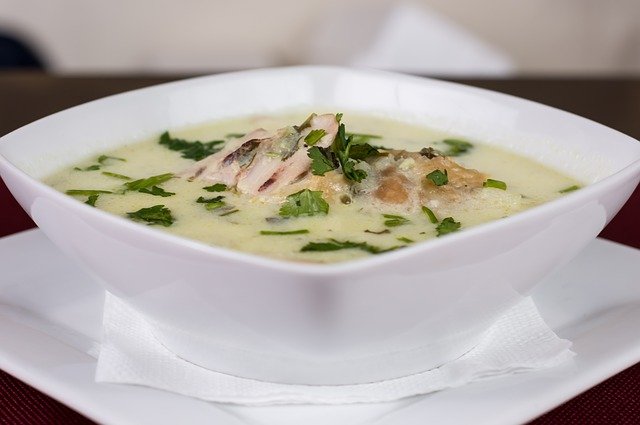
Soup is a versatile and convenient meal, but what happens if you don’t finish it all or if there are leftovers? Can you refreeze soup?
The answer is yes, you can refreeze soup. However, there are a few things to keep in mind. When reheating frozen soup, make sure it is fully cooked through. If there are any frozen chunks, they will likely not cook all the way through and could potentially cause health issues.
Also, make sure to reheat the soup on the stovetop or in the microwave – do not refreeze it after reheating in the oven.
Soup is a great way to make leftover veggies and meat stretch farther, but refreezing soup is not advisable.
This is because freezing changes the texture of food, so refreezing reheated soup causes it to lose its appetizing appeal.
If you want to freeze leftovers from a restaurant or your own homemade soups, try freezing them in ice cube trays before placing them in a freezer bag.
This will make them easier to reheat and they won’t take up as much space in the freezer.
Should you refreeze soup?
Have you ever refrozen soup after it had been thawed? Refreezing soup is probably not recommended by most chefs, as the texture of refrozen soup will become watery and grainy.
This is because refreezing changes the cellular structure and texture of food. The refrozen soup can also taste watery and have a grainy mouthfeel.
A food’s refreezing is actually based on the process of freezing and then thawing. Food refreezing has been studied since the end of the 19th century.
In a refreezing experiment, it was found that the volume of the refrozen piece of food was significantly less than that of the original piece because water from outside refroze into ice crystals as well as existing ice crystals grew larger as they refroze after being thawed.
Since soup is usually made with vegetables, meat, or both, refreezing can cause the soup to be watery and have a grainy texture.
To prevent your soup from becoming watery and having a grainy texture, you can either eat it all within two days or freeze it in small batches.
If you are going to freeze your soup, make sure that you package it in a way that will prevent ice crystals from forming and ruining the texture of the soup.
You can also thaw your soup in the refrigerator overnight so that you don’t have to refreeze it.
Regardless of whether you refreeze your soup or not, it is always important to practice safe food handling when preparing and storing your food.
What is the best way to refreeze soup?
There are a few things to keep in mind when refreezing soup.
The first is that you should make sure the soup is completely thawed before refreezing it. If there are still chunks of ice in the soup, it will not freeze properly and could spoil.
The second thing to keep in mind is the size of the refreezing container. If the soup is refrozen in a large container, there will be too much air in it and when you thaw the soup again, it will spoil quickly.
The third thing to keep in mind is that refreezing soup might make it taste different than fresh soup made from the same ingredients because refreezing can change the flavor of some foods.
If you follow these three guidelines, refreezing soup should not be a problem. Just make sure to thaw it completely before reheating it so that it doesn’t spoil.
How many times can you refreeze soup?
The answer to this question is a little tricky, as it depends on the soup itself. Generally speaking, however, you can refreeze soup two or three times without any real problems.
After that, the quality of the soup may start to diminish, so it’s best not to push it.
If you’re wondering whether or not your soup is safe to refreeze, there are a few things you can do.
The first is to take a look at the ingredients list. If any of the ingredients have been frozen before, it’s best not to refreeze the soup.
Additionally, if the soup has been cooked already, it’s probably best not to refreeze it either.
If you’re still not sure whether or not your soup is safe to refreeze, the best thing to do is to give it a taste. If it tastes okay, it’s probably safe to refreeze.
If it doesn’t taste so good, however, then you should probably throw it out and start fresh.
Of course, refreezing soup isn’t always a bad thing. In fact, there are some soups that you can refreeze indefinitely. This includes things like cream of mushroom or cream of chicken soup.
These types of vegan foods freeze very well and may actually taste better after being refrozen and heated up again.
Additionally, refreezing soup can sometimes be a good thing. For example, refreezing a broth-based soup can help to thicken the broth, which makes it taste better.
How to thaw soup?
There are two different ways to successfully thaw soup.
The first one is microwaving. This is the quickest way to thaw soup, but it can also cause the soup to become watery. If you choose to microwave your soup, make sure to stir it frequently to avoid any hot spots.
The second method is by refrigerating. If you choose to leave your soup out overnight in the fridge, make sure to put it in a tightly sealed container to prevent bacteria from growing. Leaving your soup out at room temperature can cause it to spoil quickly.
Whichever method you choose, make sure to stir the soup well before eating it to ensure that all the ingredients are evenly mixed.
Final Thoughts
I hope that I completely answered the question “Can you refreeze soup?” The next time you have leftover soup, you know what you should be doing next.
This information seems so simple but it can save your day. Knowing the right way of keeping food safe makes your life easier.
Thank you for reading.
For more info about refreezing foods, feel free to visit this page.

